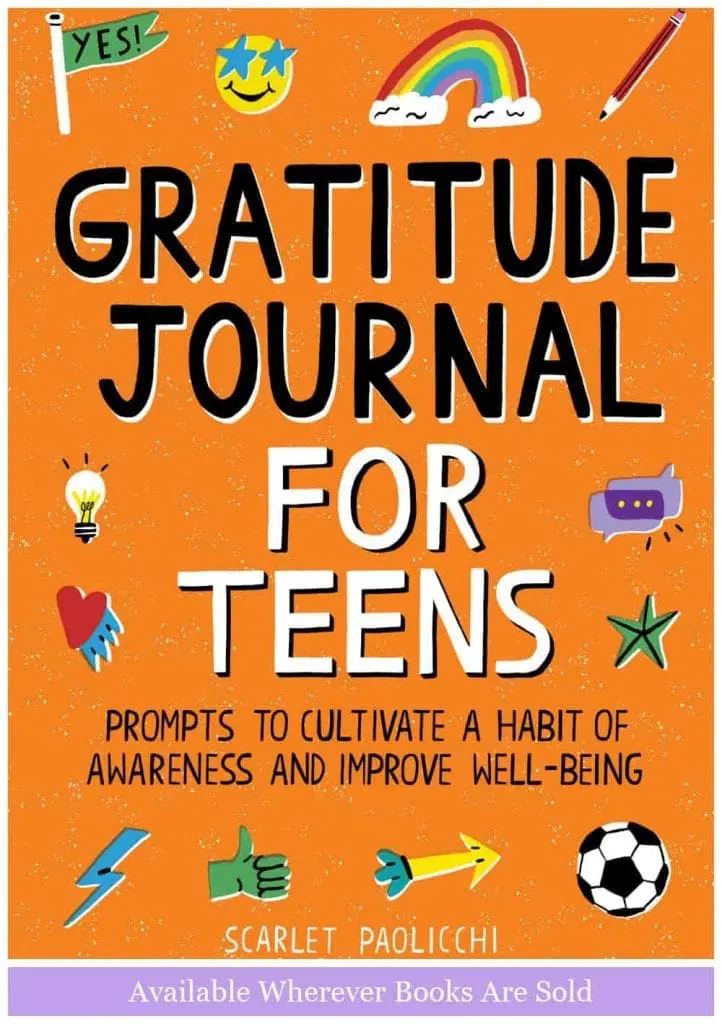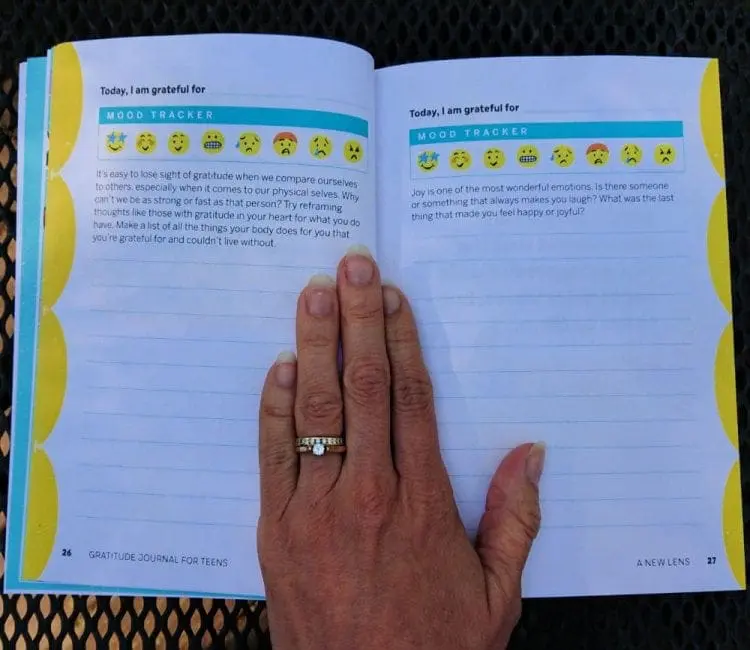After a lot of hard work behind the scenes, I’m so excited to finally announce my new book is out! It is called Gratitude Journal for Teens: Prompts to Cultivate a Habit of Awareness and Improve Well-being. This is my third book and each one has a special spot in my heart. I really cherish this one because I know firsthand the power of gratitude to overcome anxiety. It is also special to me because I am the proud mother of two teens. The teenage years are notoriously fraught with challenges. This is natural as kids begin transforming into adults and dealing with new pressures and uncertainty about the future. This journal for teens is filled with daily gratitude journal prompts and exercises. It will help establish a regular habit, track their progress, and deepen their experience with gratitude to become happier, more resilient, and positive.
This book was published May 18, 2021. I am republishing this introduction to my book to make it easier for my new readers to find and benefit from it. Gratitude journals make the practice of being appreciative easier as they provide gratitude journal ideas to direct your thoughts in enriching ways. Order this gratitude journal now through my Amazon affiliate link-> here!

What is a gratitude journal?
A gratitude journal is a place where you get to reflect on your gratitude and then write about it. The process of writing about your thoughts and feelings can help you organize them better and understand them more clearly. It helps you to become a better communicator and it can help you to find solutions to your problems. A gratitude journal can help stop the loops of negative thought patterns and replace them with a new, more fruitful way of seeing things.
Having a gratitude journal like this one is helpful because it is guides the reader through a gratitude journey. Instead of staring at a blank page, this guided gratitude practice begins with gratitude prompts. These gratitude journal examples help you learn more about what gratitude really is- a subtle but powerful perspective shift. Then the gratitude journal prompts help you turn the gratitude lens on yourself, the people around you, and even for your areas of interest. The gratitude journal ideas extend to helping teens learn to use gratitude as a tool to deal with tough times and improve resilience.
The important thing about gratitude journaling is that it helps to develop a habit to express gratitude. Doing it on a daily basis, makes it easier to focus on positive emotions and positive things. It is a great way to make finding the silver lining a new habit. Do not think this attitude of gratitude is only for big things. It is for small things too! Just as it not just for happy days. In fact, learning to focus on things we are grateful for is what helps us to get through bad days.
While this gratitude journal is written for teens, I do think that it also suitable for particularly mature kids. Most kids in the tween years of 10, 11, and 12 will probably still enjoy and benefit from this book. Likewise, it can be equally beneficial to young adults adjusting to new challenges.

Why Gratitude Journaling Is Powerful
Writing in a gratitude journal can actually help improve well- being. In fact, Teen Vogue goes so far as to say it can help improve your mental health, “Sometimes it can feel difficult to remember the good things in life. If you’re feeling depressed, anxious, or stressed, taking stock of what you’re grateful for might not be the first thing that comes to mind. But research shows that cataloguing your gratitude could improve your mental health — and Teen Vogue Editor in Chief Lindsay Peoples Wagner agrees.”
Studies have connected gratitude to greater happiness, better school performance, improved relationships, and higher self-esteem. I believe that a gratitude journal is helpful anytime. However, it is especially useful as a tool to help deal with all of the flux and uncertainty that the pandemic has brought on. The idea is that gratitude can create a perspective shift. This can help teens overcome particularly rough patches of those sometimes tumultuous teenage years.
Robert Emmons is a professor of psychology and a leading expert on gratitude. He says in Greater Good Magazine, “For more than a decade, I’ve been studying the effects of gratitude on physical health, on psychological well-being, and on our relationships with others…Gratitude journals and other gratitude practices often seem so simple and basic; in our studies, we often have people keep gratitude journals for just three weeks. And yet the results have been overwhelming. We’ve studied more than one thousand people, from ages eight to 80, and found that people who practice gratitude consistently report a host of benefits”. He goes on to list various benefits. These include stronger immune systems, to more optimism and happiness, to feeling less lonely and isolated, and many more.
How Gratitude Journal Ideas Can Help Your Teen Learn Gratitude
There are many ways to teach your child gratitude but journaling is perhaps the most direct and meaningful. However, this book is not a replacement for a therapist, medication, or medical treatment. If a child is suffering from depressive symptoms, please consult with a qualified professional.
When I told my own teenage daughter about the gratitude journal I was writing she said, “Oh yes, my friend’s therapist suggested she keep one.” I suggested it was a good idea for my daughter keep one too! And now that I have written one, I hope it is the best gratitude journal for teaching teens. I want it to teach about what gratitude really is and how to practice it daily. At the end of the day, it is a great way to focus on the positive aspects of your life. This helps develop a positive mindset.

Gratitude Journal for Teens: Prompts to Cultivate a Habit of Awareness and Improve Well-being
Dealing with stress and uncertainty about school, friends, and the future can be hard for teenagers. That is why learning to practice gratitude is so important. It gives them a tool they can use now and throughout their lives to to recenter and improve resilience. That is a great thing to do on a regular basis!

Uncover the power of gratefulness with these thought-provoking prompts that go beyond the typical and mundane. These gratitude journal prompts will transform the mindset and challenge perspective. They serve to help you see the world in a new light, and unleash the incredible benefits of gratitude in your life.
Thematic Gratitude Journal Examples & Prompts
This journal for teens helps teens to record a little bit of gratitude every day. This helps them to get in the habit of keeping a content and resilient mindset. Each entry includes daily repeating elements. There is a quick check in on something they are grateful for and on how they are feeling. They also include a brief writing prompt or reflection. These encourage teens to notice and remember what they’re grateful for around a specific topic.
There are four sections to the book and they are focused on different goals for teens. Gratitude journal examples from this book focus on adjusting how one sees the world and shifting gratitude onto one’s self. Additionally, managing negative thoughts, and being mindful of each moment. Each section has quotes, daily gratitude journal prompts, and exercises to help develop gratitude for everything big and small!

Where To Buy This Gratitude Journal
This gratitude journal makes a great gift to help teens grow their experience of gratitude. It is a powerful way to make a big difference in someone’s daily life.
It is available wherever books are sold. You can get it at your local book store or you can go ahead and order it from Amazon now!
Reviews
“This book is such an amazing way to help teens get in touch with their feelings, recognize what they have, and be appreciative of it. It’s not that teens aren’t grateful, it’s just hard being a teen and sometimes they don’t see the whole picture. These short but effective exercises ask teens to look at different areas of their life and write about the things that bring them joy and happiness, focusing on the positive things in their life and helping them to appreciate the little things as well as the big!” ―Lisa O’Driscoll, lifestyle blogger, funmoneymom.com
“It is hard to prepare our children for an uncertain future. Helping them learn the art of gratitude can transform their lives now and forever. The Gratitude Journal for Teens makes the job of helping my teens embrace gratitude easy. The journal is perfectly on-point for this age group and gives teenagers the skills to learn more about themselves and how they can transform any circumstance into an opportunity for gratitude.” -Jami Yonash, family blogger, lifeissweeterbydesign.com
“In a time when teens can feel overwhelmed, Gratitude Journal for Teens provides inspiring quotes and prompts to help kids be more aware of the small things in life. This journal is the perfect gift for teens of all ages.” -Christina Hitchcock, simple recipes for busy families, itisakeeper.com
“Some of us underestimate all our teens have to deal with today. This new gratitude journal may not be the answer to all your teens’ problems, but it can certainly be part of the solution as the learn to look at life through a different lens.” -Sami Cone, YouTuber, TV Show Host, Author, RaisingUncommonKids.com
“This journal offers techniques that help with focusing on gratitude and positivity, resulting in greater happiness, better school performance, improved relationships, and higher self-esteem. Each prompt is formatted to help center and focus on feeling your feelings, as well as ways to find gratitude in the moment.” –ChoosingTherapy.com
Conclusion
Embrace a new level of introspection and joy with these thought-provoking gratitude exercises. It is my hope that whoever you are, whatever is going on in your life, you will benefit from these gratitude journal ideas and creating a daily gratitude practice. The gratitude journal examples can really help create a new, more positive mindset. I hope it helps you to developing a long-lasting, meaningful practice of gratitude.
Would you like to experience the transformative power of gratitude in your daily life? Do you think your teen would benefit from cultivating greater awareness of their surroundings? Would you like them to learn to have gratitude for themselves, others, and their life at large?
My Other Books:
A Journal For Grandparents And Grandchildren

Roxanne says
I agree. Gratitude helps reduce toxic emotions like envy, resentment, frustration, and regret. Research shows that gratitude can significantly increase happiness and lower symptoms of depression. Thank you for sharing such an informative blog post!
Raven says
This gratitude journal for teens is such a fantastic idea! I love how it encourages self-reflection and positivity. The gratitude journal examples are really thoughtful and will definitely help teens cultivate a mindset of appreciation. Can’t wait to try this out with my own kids!
Tanya says
I love these gratitude journal ideas. I especially like the section that centers around expressing gratitude toward people around you which strengthens social bonds. Whether in family, friendships, or romantic relationships, appreciation fosters deeper connections and mutual support.
Conor says
I ordered this book for may daughter a few weeks ago because I heard that during during difficult times, gratitude helps you stay grounded and focused on the positive, increasing your ability to cope with stress and challenges. I think the gratitude journal prompts have been helping so thank you.
Amber Bro says
This article really resonated with me! It’s a great reminder of how small daily acts of appreciation can make a big difference in well-being. Highly recommend! After all, gratitude is the key to happiness. You can’t be anxious and grateful at the same time because focusing on what you appreciate helps regulate the nervous system and reduce stress hormones.
Aria Jade says
This is such a thoughtful and much-needed resource for teens navigating a complex world. Incorporating gratitude practices can genuinely boost mental well-being and resilience during these formative years. The examples and daily prompts are practical, relatable, and easy to start with. Thank you for creating a tool that empowers young people to focus on positivity and self-reflection!
SHM says
Really enjoyed reading this—it’s refreshing to see content that speaks so directly to teens and their emotional growth. The prompts are clear, inviting, and designed to gently build a habit of awareness without pressure. I especially appreciate how this combines scientific findings about gratitude with practical tools for self-reflection.
In my work helping websites around wellness and education, I’ve found books perform best when they balance inspiration with structure—daily prompts, consistency, and a sense of permission to explore. Thanks for sharing something such a meaningful book!
Sachin Kumar says
I love how this journal turns simple prompts into powerful daily habits. Thank you for giving teens a meaningful tool to see the good even during tough times.
Tele says
This is such a beautiful project — congratulations on publishing your third book! The teenage years really are a time when gratitude can make such a big difference. I love how your journal uses prompts to guide teens instead of leaving them with a blank page. It feels like a powerful tool to help build resilience and positivity.
West Fencewright says
Love the idea of a gratitude journal with prompts for teens—it’s a great way to help them reflect and build emotional strength early on. Thanks for sharing these thoughtful tools!
Lance Kim says
Love these journal prompts — they’re such a great way to help teens build positivity and self-reflection. Thanks for sharing tools that support emotional growth!
Daniel says
I really appreciate this post on gratitude journaling for teens. It’s such a practical way to help young people build mindfulness and resilience in their daily lives. I like how you included examples and prompts—it makes the practice much less intimidating, especially for beginners. Gratitude journals can also encourage positive communication at home, since teens often share what they’ve written. Thanks for presenting it in such a relatable and encouraging way!
Delhi says
I completely agree! Gratitude helps reduce toxic emotions like envy, resentment, frustration, and regret. Studies show it can boost happiness and lower symptoms of depression. Thank you for sharing such an insightful blog post!
vikas says
This is such a helpful resource! Daily prompts make it easy for teens to practice gratitude and build a positive mindset—love the examples too.
Patty says
This is such a valuable resource for teens as they navigate today’s complex world. Practicing gratitude can truly strengthen mental well-being and build resilience during these formative years. The examples and daily prompts are simple, relatable, and easy to put into practice. Thank you for offering a tool that helps young people embrace positivity and self-reflection!
devirsoft says
This is a thoughtful and practical resource for teens to cultivate gratitude. The examples and daily prompts make it easy and engaging to build a positive daily habit.